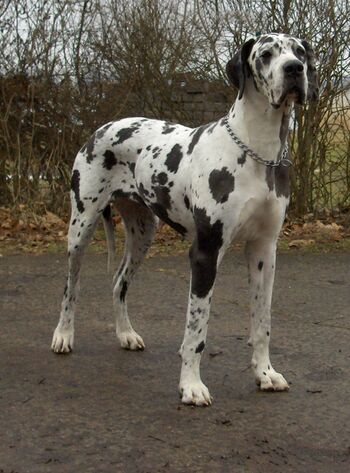Great Dane
The Great Dane is a large breed of dog. It is the tallest of the working breeds, and is informally described as a "giant" breed. A Great Dane called 'Gibson' is currently the world's tallest living dog, according to the Guinness Book of World Records.
Classed as a member of the 'working group' by the Kennel Club (Great Britain) and as a 'working dog' by the American Kennel Club, its name is derived from "the old French designation, grand Danois, meaning Big Danish"[1]. George Buffon, an eighteenth century French naturalist, used this name in describing the breed, and the English speaking world has since used its translation. Germans, however, use the name Deutsche Dogge (German Mastiff); the present day dog was developed by German breeders during the nineteenth century. The Great Dane was first displayed at a Hamburg dog show in 1862.[2]
Appearance
Great Danes are of imposing size. The requirements differ slightly among kennel clubs, but the American Kennel Club standard calls for males to stand no less than 30 inches (76 cm) at the withers (the top of the shoulders) and females must be at least 28 inches (71 cm); they weigh 120 to 150 pounds (54 to 68 kg).
Coat
Great Danes are recognized in the following colors and patterns:
Colours:
- Blue
- Black
- Fawn
Patterns:
- Brindle
- Harlequin
- Mantle
Cropping and docking
There are two acceptable fashions for a Great Dane's ears. They may be left natural, as the harlequin Dane's ears are shown in the photograph above right. Some breeders prefer to crop their puppies' ears. The ears will stay erect, but must be taped in position for the first several months of the pup's life in order to do so reliably.
A docked tail is a disqualification in this breed.
Sexual dimorphism
All Great Danes must exhibit sexual dimorphism, which means that males must look and females must look decidedly different. It must be easy to recognize a Dane as looking masculine or feminine.
Health concerns
Great Danes are more likely than other breeds to suffer difficulties,associated with being very large such as "bloat", a painful gastric disorder, and hip dysplasia.
Genetic blindness and deafness have been associated with Great Danes lacking in pigment.
References
